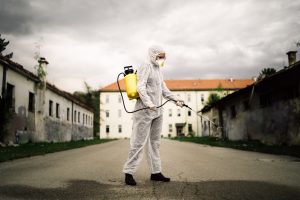The National Institute for Occupational Safety and Health (NIOSH) September 7 released fact sheets covering counterfeit N95 filtering facepiece respirators (FFRs) and the institute’s filtration efficiency testing and employer FFR fit testing. Last year, NIOSH and personal protective equipment manufacturers reported a rise in counterfeit FFRs following respirator shortages at the beginning of the COVID-19 pandemic.
NIOSH evaluates and approves all respirators. The Food and Drug Administration (FDA) regulates surgical masks and respirators used in healthcare facilities under its medical device authority, and NIOSH tests N95 respirators for healthcare use under a memorandum of understanding with the FDA.
The easiest way to tell if your N95 is NIOSH-approved is to search for it on the NIOSH Certified Equipment List. NIOSH-approved respirators have a series of markings: company name or logo, model or part number, protection rating (N95, N99, N100, R95, R100, P95, P99, or P100), TC-Approval Number, and NIOSH in capital block letters. Respirators also may have a lot number.
According to NIOSH, signs that an N95 may be counterfeit include the following:
- There is a lack of the required label markings on the FFR.
- NIOSH is spelled incorrectly.
- It has decorative fabric or decorative add-ons like sequins.
- It claims to be approved for children. NIOSH does not approve any type of respiratory protection for children.
- It has ear loops that do not use a fastener to connect them behind the head. A NIOSH-approved respirator has a set of two head bands or ear loops that are approved for use and have a connecting fastener.
NIOSH, employer testing
All NIOSH-approved FFRs must pass a standardized test to verify that tiny particles like bacteria, dirt, dust, and viruses will be captured by the respirators’ fibrous filtration media, a weave of electrostatically charged synthetic filter fibers, when worn. NIOSH tests simulate a “worst-case scenario” of particle capture, following two approaches:
testing with particles without an electrostatic charge, which are harder to filter, and using particle sizes known to be the most challenging to filter, such as particles with a 0.3-micron diameter.
For example, the two-pronged “worst-case scenario” test of a NIOSH-approved N95 FFR ensures the respirator’s filtration media will capture at least 95% of non-oil aerosols when the wearer inhales through the respirator media.
Employer fit testing ensures that respirators form a tight seal to the wearer’s face. Under Occupational Safety and Health Administration (OSHA) respiratory protection program regulations, employers must conduct fit testing with employees before respirators are used in the workplace. Fit testing also is required at least annually thereafter and whenever a different respirator facepiece is used or a change in the employee’s physical condition (facial hair, scarring, weight loss, or weight gain) could affect respirator fit.
Employers may use either qualitative or quantitative fit testing, as detailed in OSHA’s guidelines.
A qualitative fit test is a pass/fail test that determines whether a respirator user can detect a test agent (for example, taste). A quantitative fit test uses an instrument to measure inward leakage of a respirator that has been donned, allowing employers to calculate a “fit factor” for the respirator.

